Getting your snowmobile’s track adjusted correctly doesn’t have to be complicated. In this guide, we’ll show you the tools, step-by-step instructions, and troubleshooting tips for all major brands — Polaris, Ski‑Doo/Lynx, Arctic Cat, Yamaha, and more. If you do it right, your snowmobile will run great quickly. Why Track Tension Matters Track tension directly affects […]
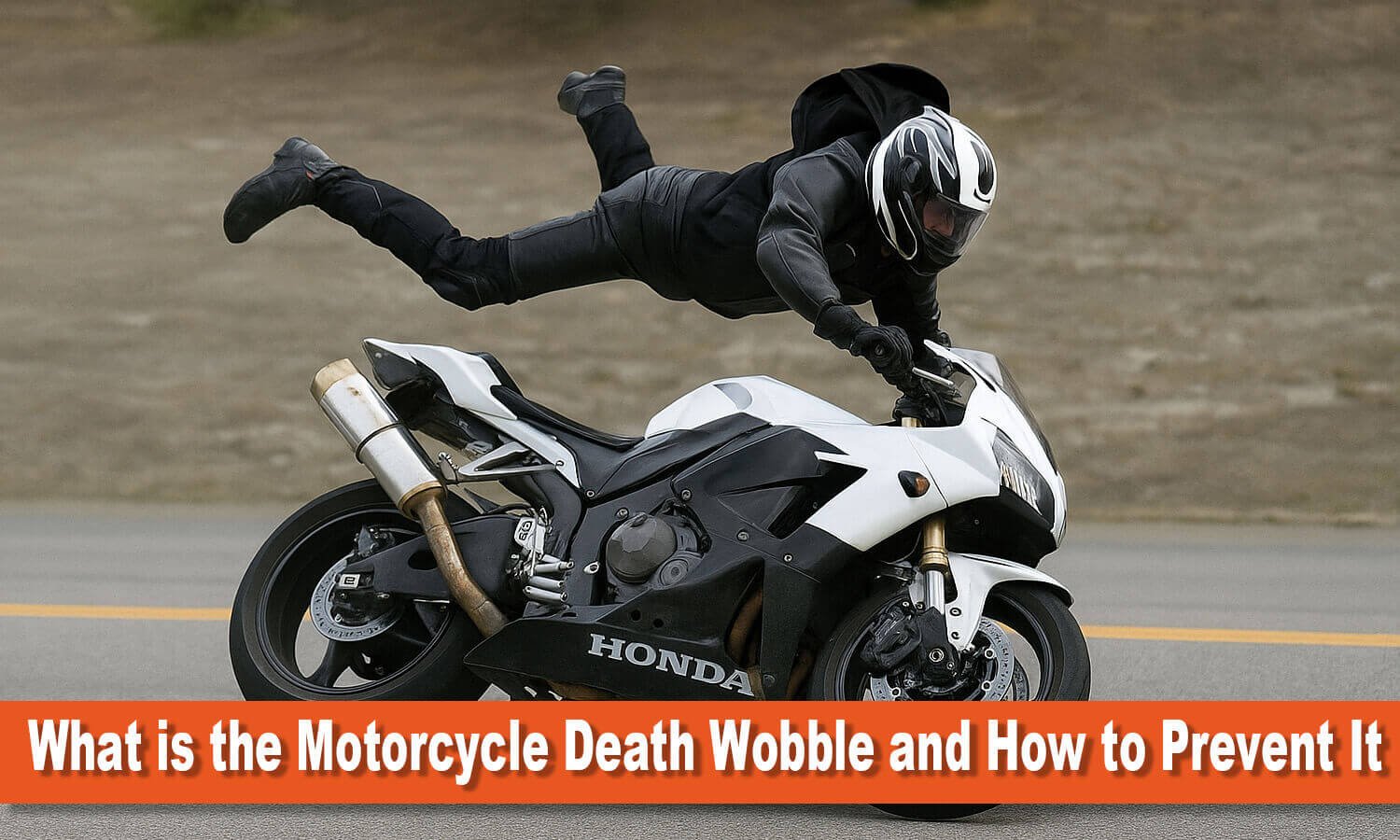
What is the Motorcycle Death Wobble and How to Prevent It
Motorcycle riders understand that riding fast demands full attention at all times. A scary but unusual problem they might experience is the motorcycle death wobble. This happens when the front wheel or handlebars start shaking at high speeds. Even though it sounds frightening, the positive news is that death wobbles are rare in today’s motorcycles and can be stopped with good maintenance and careful riding habits.
This article explains what triggers motorcycle death wobble, how you can prevent it, and what steps to take if you face it.
Table of Contents
What is the Motorcycle Death Wobble?
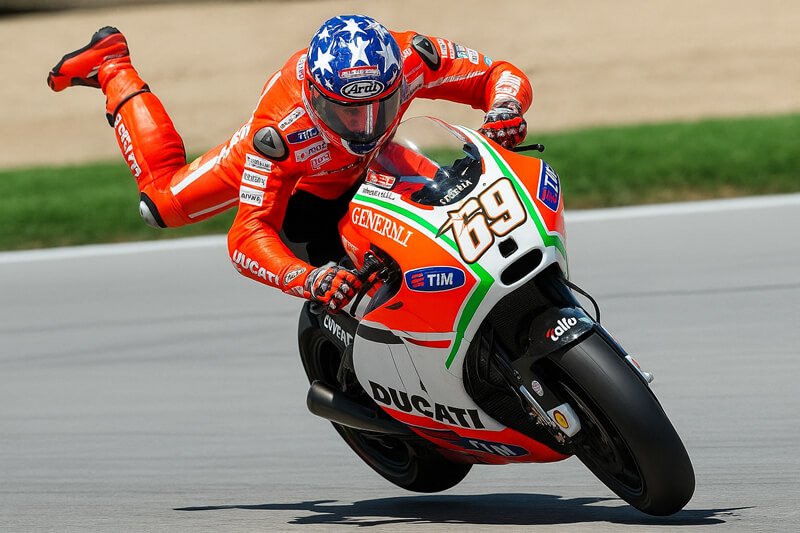
Motorcycle death wobble
The death wobble (also called a speed wobble or tank slapper) is a rapid front-end oscillation of a two-wheeled vehicle. In technical terms, it is a 4–10 Hz oscillation in the steering geometry often caused by a resonance between the bike’s speed and a steering disturbance.
In plain language, it feels like the front wheel violently shaking back and forth at high speed. This typically occurs when the front wheel is momentarily lifted (for example, from a bump or hard acceleration) and then returns to the road under misaligned forces. Instead of settling straight, the handlebars overshoot and swing like a pendulum. When a wobble builds up, the bike may begin to weave or dart laterally, making steering almost impossible.
Death wobbles are extremely frightening to riders, but they are uncommon on well-maintained motorcycles. Most riders will never actually experience one. The key is that some imbalance or looseness in the bike’s front end lines up with speed to create a positive feedback loop.
If there is too little steering damping or a significant disturbance, the oscillations can amplify until the bike pitches erratically. At that point, riders often instinctively grip tighter or brake hard, but fighting the wobble usually makes it worse. Instead, the accepted best response is to keep a loose grip, ease off the throttle, and let the bike settle.
Common Causes of Motorcycle Death Wobble
Motorcycle death wobble happens when one or more factors upset the motorcycle’s natural stability. Typical causes fall into three categories: mechanical issues, environmental factors, and rider behavior. In practice, multiple factors often interact. For example, a rough road (environmental) combined with a slight misalignment (mechanical) at high speed (rider/behavioral) could trigger a wobble.
Mechanical Factors
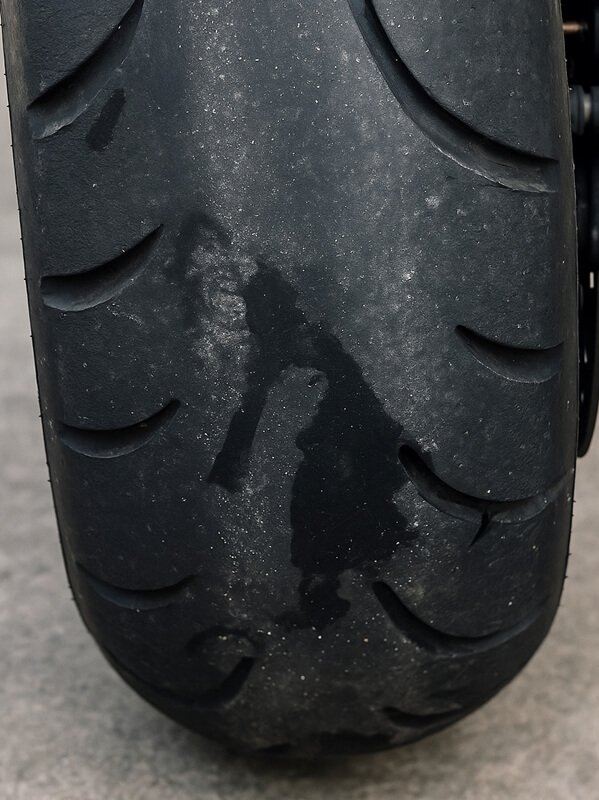
uneven motorcycle wheel
Uneven or poorly balanced wheels and tires are a leading cause. An out-of-round tire, bent rim, or heavy spot on a wheel creates cyclic forces that can excite the steering at speed. Similarly, worn-out or loose steering components – such as head bearings, steering stem nuts, axle pinch bolts, or triple-clamp hardware – let the front end flop or develop play.
For instance, worn steering head bearings or a loose triple-tree clamp can allow slight steering drift that turns into a wobble. Bad wheel bearings or improper axle alignment can also introduce slop. In some designs (notably certain Harley-Davidson cruisers), defective engine mounts or rear suspension linkages have been implicated in amplifying rear-end vibration into a front-end shake.
Finally, inadequate suspension setup – such as sag that’s too low/high or sprung weight mismatched to the bike, may contribute. If the front forks are too soft or misadjusted, the wheel can move freely and start to shimmy after a hit.
Environmental Factors

Loose gravel surface
Road conditions and wind can spark a wobble. Hitting a bump, pothole, or rough pavement at speed can kick the front wheel sideways just enough to start oscillation. Even small imperfections (railroad tracks, asphalt seams, loose gravel) can be amplified. Strong crosswinds or turbulence from passing vehicles can also disturb a motorcycle’s straight line and contribute to a shake.
High speed itself is a factor: going very fast can “displace the alignment” of the bike and magnify any disturbance. In fact, one rider wrote that simple bumps at high speed turned into a wobble because the bike’s alignment was shifted by velocity.
Rider Behavior
How a rider accelerates, brakes, and handles the bike affects stability. Sudden throttle openings or abrupt braking can shift weight and change wheel traction unpredictably. For example, popping a wheelie or accelerating aggressively can cause the front wheel to rise and then slam back, initiating a wobble.
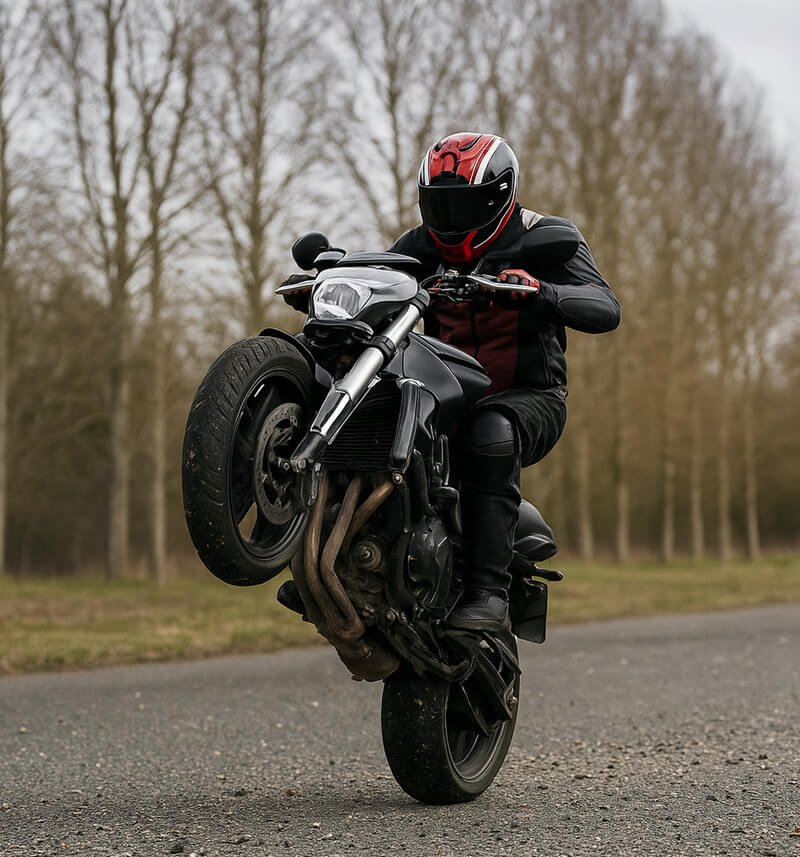
popping a wheelie
Riding too fast for conditions is a top contributor – in U.S. crash data, 35% of fatal motorcycle accidents involved speeding or excessive speed for conditions. High speed also means longer reaction time for small disturbances. A tense grip on the bars or panicky inputs during a wiggle will usually aggravate the oscillation. Improper loading of luggage or a passenger can unbalance the motorcycle and make wobbles more likely.
In short, riding style and speed must match the bike’s stability margin – going beyond it can turn a minor shimmy into a full-on death wobble.
How to Prevent Motorcycle Death Wobble
Avoiding the motorcycle death wobble comes down to proper upkeep and careful riding. Keeping the front end secure, balanced, and steady helps prevent most mechanical problems. Riding lowers the chance of triggering this issue. Check out these tips to stay safe:
1. Check Tires and Wheels
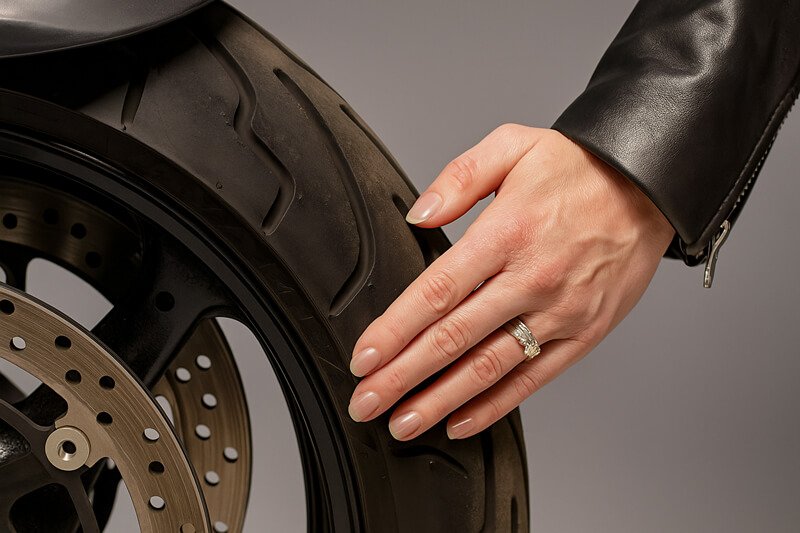
check tires and wheels
Make sure to check tire pressure and tread. Low-pressure tires or uneven wear can cause wobbling.
Always inflate tires to the manufacturer's recommendation and replace them if the tread is uneven or worn down.
Get your wheels balanced by a professional when you put on new tires. Even a tiny imbalance can lead to serious vibrations at high speeds.
Look over the wheels to spot any bends or dents in the rims and ensure spokes, if your wheels have them, are straight and tensioned. A balanced wheel setup reduces the risk of disturbances from the start.
2. Check and Adjust Steering Parts
Before riding, check the steering head for any looseness. Hold the forks and move the bike back and forth to see if the head bearings are loose.
Worn or loose bearings should be fixed or swapped out by a skilled mechanic.
Make sure the steering stem nut is tightened. Confirm that all key parts, like the triple clamps, handlebar clamps, axle nuts, and pinch bolts, are fastened. Loose components in this area may cause wobbling while riding.
Replace damaged or rusty hardware, and apply threadlocker on bolts if needed, because vibrations can make bolts come loose over time.
3. Service Suspension and Frame
Suspension should be adjusted to match the bike’s weight and purpose. Set fork sag and spring preload according to the owner’s manual or a suspension technician’s guidance.
If the suspension is worn, leaking, or bottoming out, have it rebuilt. The front forks must be aligned and sliders in good condition so that the wheel tracks straight.
Check that the steering head bearings, fork sliders, swingarm, and frame mounting points have no cracks or excessive wear. A bent frame or misaligned steering geometry (for instance after a crash) can cause wobble. Correct any such damage.
4. Use a Steering Damper
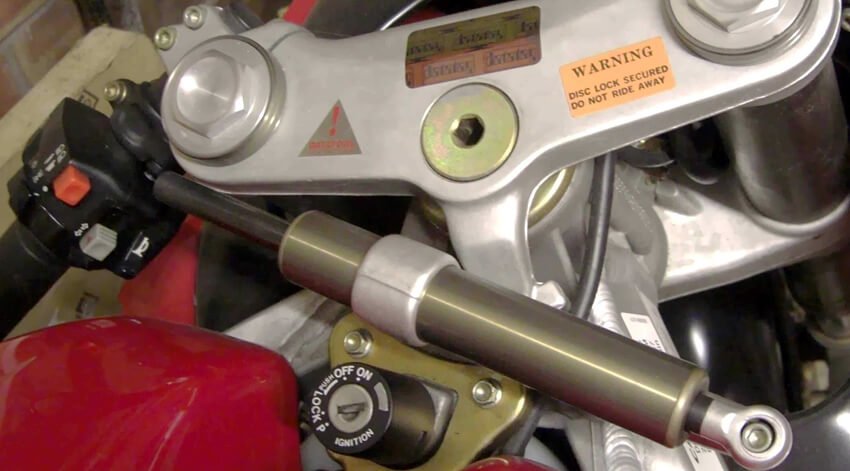
motorcycle steering damper
Many modern motorcycles either come with or can be fitted with an aftermarket steering damper (stabilizer). A damper is a shock absorber for the steering, which suppresses sudden oscillations. Installing a quality steering damper is highly recommended for high-speed riding or performance bikes. It will not cause wobble, but it adds valuable damping to prevent a shake from building.
For bikes that did not originally have one, consider adding either an adjustable steering damper or even simple bar-end weights. Racers and off-road riders often run adjustable dampers so they can tune it for their weight and speed range. In short, a well-chosen damper (properly set) greatly raises the speed threshold at which a wobble can occur.
5. Balance Luggage and
If you carry gear, make sure the load is balanced left-to-right and front-to-back.
Overloading the rear or having an unsecured heavy tank bag can alter steering feel. Strive to keep the center of mass low and centered. Evenly distribute any panniers or top cases, and avoid exceeding the bike’s maximum load capacity. A heavy, loose item can shift its weight during a ride and send a wake of oscillations through the chassis.
6. Ride with Good Technique
Stable riding form helps prevent and manage wobbles.
Keep a light, relaxed grip on the bars – a death wobble will feel much worse if the rider fights it with a death grip. Sit upright with knees gently on the tank; gripping the tank with your legs will help stabilize the bike. Maintain a smooth throttle and brake application. Avoid jerky steering or shifting your weight suddenly at high speed. In corners or on uneven pavement, try to keep the suspension in its mid-range of movement rather than in hard compression or extension.
7. Be Cautious in High-Risk Situations
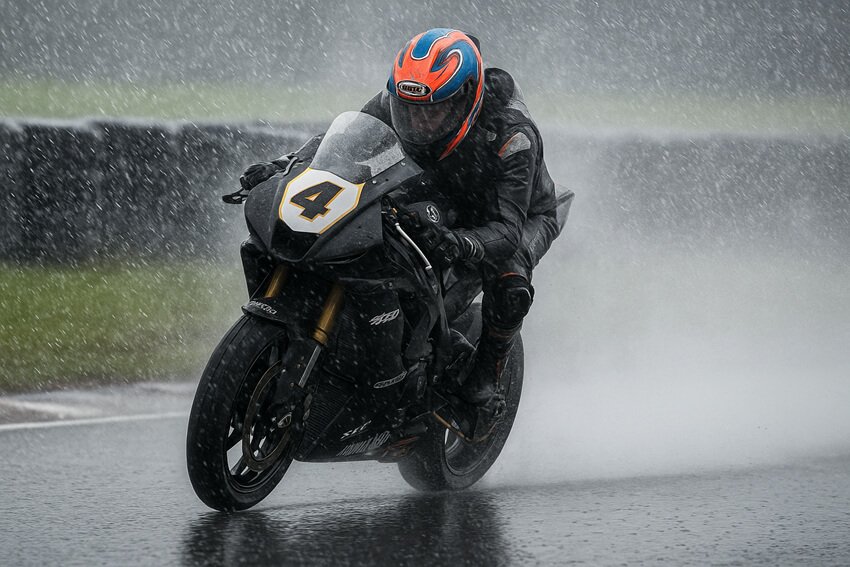
motorcycle in poor weather
When road conditions or weather are poor (rain, gravel, crosswinds, etc.), slow down and anticipate bumps. A high-speed bump that you would normally roll over smoothly can trigger a wobble if conditions align.
In mountainous or unfamiliar terrain, be especially alert for rail crossings, large stones or washboard surfaces. And always ride within your and your bike’s limits. Remember that on a motorcycle, excessive speed magnifies every small issue.
8. Regular Maintenance Schedule
Don’t neglect routine services.
Check steering play and tire health before every long trip. Have your mechanic torque the forks and wheel bearings annually. Replace aging steering head bearings or fork seals proactively.
If you notice any unusual vibration or shimmy – even a slight one – have it checked immediately. Early intervention is key. Many documented wobble incidents have occurred on bikes with neglected maintenance.
What to Do If a Wobble Starts
Even with precautions, a rider may occasionally encounter the beginnings of a speed wobble. It’s important to stay calm and respond correctly. Do not grab the bars or jam on the brakes, as that often makes the oscillation worse. Instead:
- Loosen your grip and keep your arms relaxed.
- Gently roll off the throttle to slowly decelerate. Maintain speed only so you don’t lose balance, then coast.
- Look ahead – focus on the road where you want to go, not at the wobbling wheel.
- Shift your weight slightly back or adjust your posture (for example, by pulling back on the handlebars) to lighten the front end.
- Let the motorcycle slow itself down. Usually the wobble will naturally subside as you reduce speed. Once stable, pull over to inspect the bike.
Experts often compare it to a shuddering car after a flat tire: the best fix is slow, steady deceleration and avoiding overcorrection.
If the wobble does not stop, it is generally safer to continue slowing down in a straight line than to pull out of the road or suddenly jump off the bike. However, if an accident seems inevitable, safely leaping clear may be less dangerous than fighting the bike.
Conclusion
The motorcycle death wobble is a frightening but preventable phenomenon. By keeping tires balanced, suspension and steering properly maintained, and by riding with good technique, most wobbles can be avoided entirely. Modern bikes with well-tuned suspensions and optional steering dampers make full tank slappers very rare.
Key safety advice is to ride within the motorcycle’s capabilities – especially on unfamiliar or rough roads – and to inspect your bike regularly. According to safety data, excessive speed plays a role in a large share of motorcycle crashes, and high speeds can trigger wobbles. In practice, that means going easy on the throttle, especially over bumps.
Don’t let the thought of a death wobble stop you from enjoying your rides. If your motorcycle works and you stay cautious, it’s pretty rare to encounter. Stay focused, ride, and your bike will stay steady out there on the road.
You may also be interested in: Top 3 Motorcycle Dangers and Prevention Strategies

With over 10 years of experience working on cars and trucks Item Training Supervisor Richard Reina is known around the office as one of our technical experts & real an "automobile person".
His rate of interest began, in his very own words, "at the age of two when his father educated him the distinction in between a Chevy and a Ford. Since then it's been cars regularly."
As a serious lover of practically all things with a motor Richard can address nearly any kind of inquiry related to car upkeep, fixing, or restoration & is a fact professional in electric motor background.
Motorcycle riding is all about the sense of freedom, adventure, and thrill of the open road. But come on—being connected when you ride isn't always an easy thing. Whether you're riding with a buddy, navigating traffic in the city, or long-distance riding, effective communication is crucial. That's where the Fodsports T5 and T6 come in, […]
If you're looking for a new motorcycle intercom system this year, Fodsports has something exciting in store. The company has launched two new Bluetooth helmet intercoms: T1 and T1 Pro. Both models bring upgraded features, sleek design, and high-definition audio quality for riders who want to stay connected, entertained, and safe on the road. But […]
Fodsports T1 and T1 Pro: The Newest Bluetooth Intercoms for Riders. Whether you’re cruising on highways, exploring rugged trails, or commuting daily, clear communication is key. Fodsports is thrilled to launch its latest Bluetooth intercoms: the T1 and T1 Pro. Built for riders who demand reliability, versatility, and crystal-clear sound, these devices redefine how you […]
Many riders who aren't so tall or ladies just starting to ride bikes need to pick out the best Motorcycles for Short Riders and Women. They gotta look for three key things: a seat that's not too high up, a bike that's not too heavy, and something that looks good enough to give them confidence. […]
Fodsports FX 60C vs FX30C Pro: What's new techs are the FX 60C bringing to us? Fodsports is a brand worth-mention for helmet communication and video recording. This brand has established itself as a key player with its innovative Bluetooth camera intercom systems. Recently, Fodsports has released a new camera intercom, the FX 60C. How […]
